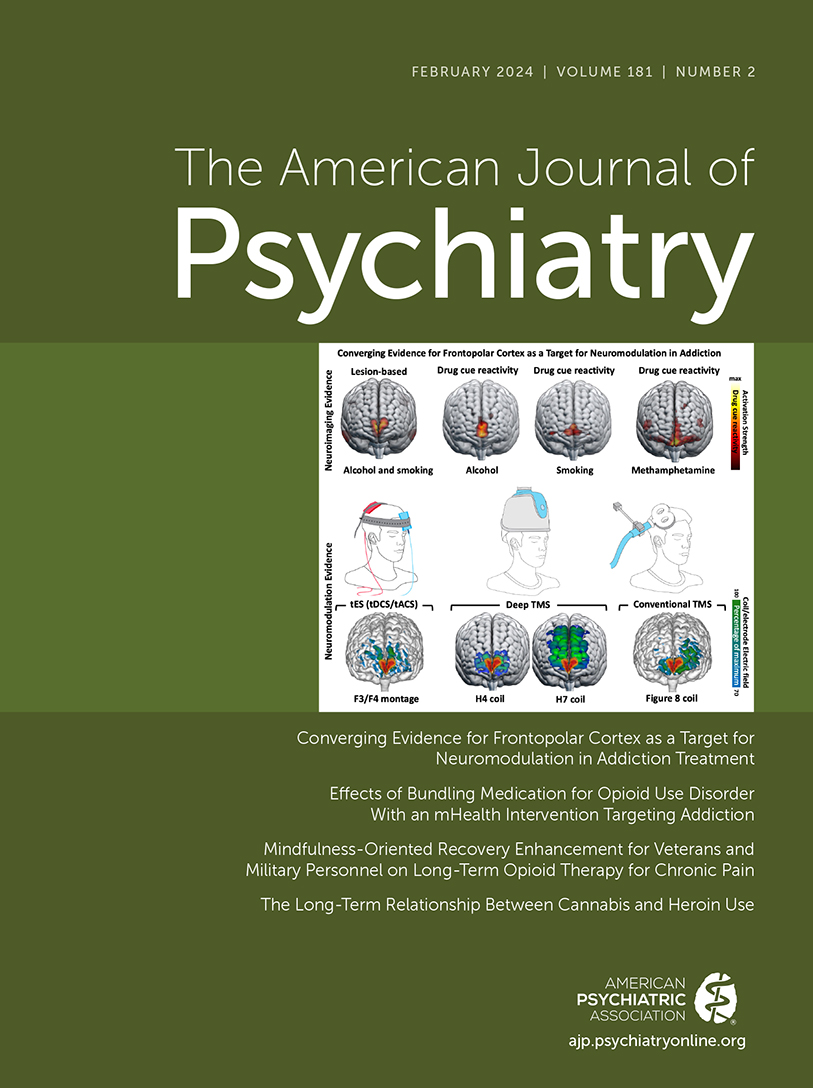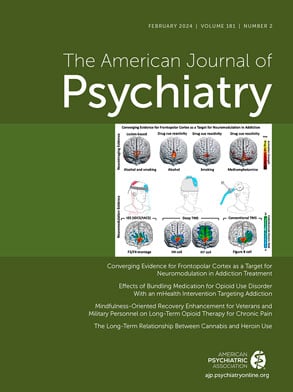In a new neuroimaging study presented in this issue, Huang et al. (
1) report important functional MRI (fMRI) results showing that the brains of heroin-addicted users are hyperreactive to drug-related cues. That is, drug-related cues triggered more intense corticolimbic activations in heroin users than in healthy control participants, and drug cues also triggered more intense activations in heroin users than did palatable food cues in the same individuals. Further, Huang et al. probed the ability of individuals to voluntarily regulate their limbic brain reactivity to cues, via recruiting cortical circuitry for top-down cognitive reframing: either downregulation of drug cues by self-distancing or upregulation of food cues by savoring taste and deliciousness in imagination.
Two neuroscience theories of addiction posit that drug cues trigger limbic hyperreactivity in people with drug addictions. First, the impaired response inhibition and salience attribution (iRISA) theory (
2,
3) posits that the salience of drug cues grows in addiction to make cues more perceptually noticeable and able to capture attention, a bit similar to increasing their brightness, while the capacity for top-down self-control simultaneously diminishes. Second, the incentive sensitization theory (
4,
5) posits that mesolimbic sensitization of incentive salience makes drug cues more tempting and able to elicit approach and consumption as well as more attention-grabbing, and so increases drug cues’ ability to trigger intense surges of motivational “wanting” to take drugs again.
Neural Hyperreactivity to Drug Cues in Heroin Users
Huang et al. compared the brain signature patterns of limbic activations triggered by visual presentations of opioid drug cues versus palatable food cues or neutral cues in 32 heroin users (seven women and 25 men, all maintained on methadone or buprenorphine to prevent withdrawal) and 21 healthy control participants matched for age and sex. Drug cues were photos of drug paraphernalia or of people snorting, injecting, or smoking heroin. Food cues were photos of palatable foods.
The results showed that drug cues triggered hyperreactive activations in the limbic circuitry of heroin users, assessed both on a within-subject basis (that is, heroin users showed higher neural activations to drug cues than to food cues) and on a between-subject basis (that is, heroin users showed higher neural activations to drug cues than healthy control participants did). Specifically, heroin users showed higher fMRI activations triggered by drug cues than by either food or neutral cues in the nucleus accumbens, anterior cingulate cortex, ventromedial prefrontal cortex, and inferior frontal gyrus, with nominally significantly higher activation also in the orbitofrontal cortex and posterior cingulate cortex. By contrast, healthy control participants showed higher activations triggered by food cues than by drug or neutral cues.
Higher subjective ratings of drug craving obtained from heroin users after the fMRI session were positively correlated with higher activation in the ventromedial prefrontal cortex, with nominally significantly higher activation in the orbitofrontal cortex and inferior frontal gyrus. Such correlations imply that limbic hyperreactivity to drug cues may underlie more intense subjective feelings of addictive craving. Huang et al. note that the correlation of higher subjective craving ratings with hyperreactivity to opioid drug cues in the nucleus accumbens, anterior cingulate cortex, ventromedial prefrontal cortex, and orbitofrontal cortex is similar to previous reports that craving was correlated with limbic hyperreactivity for cocaine, alcohol, cannabis, and heroin (
6–
9), and that higher cue-triggered activations and craving may also indicate a greater risk of relapse (
9,
10). Huang et al. conclude from their results that “such heightened drug cue reactivity at the expense of attenuated reactivity to non-drug reward extends the iRISA model to individuals with heroin use disorder. These results are also consistent with other influential accounts of drug addiction, including the incentive-sensitization theory, which invokes the upregulation of the dopaminergic system as the underlying mechanism of drug-biased salience attribution in drug addiction.”
Effective Top-Down Cognitive Regulation
In an additional interesting probe, Huang et al. assessed whether individuals could cognitively revalue drug or food cues, either downward by cognitively distancing themselves from drug cues, or upward by deliberately savoring food cues. For cognitive devaluation of drug cues, participants were asked to “Try to imagine that the scenario is not real, that it is from a movie, and these are all actors”; or “Try to imagine that the heroin is not real, that it is just a prop”; or “You can focus on how this is just a picture, and tell yourself that it is not real heroin.” For cognitive savoring of food cues, participants were told, “You can imagine that you are holding the food in the picture, and feeling the weight of it in your hands, enjoying its pleasant smell”; or “You can focus on how good the food looks or imagine how good it would taste, savoring the delicious taste of the food”; or “Imagine the sensation of how it would feel in your mouth or how it feels once you’ve eaten it.”
Interestingly, Huang et al. report that brain activations during cognitive revaluation did not significantly differ between heroin users and healthy control participants. However, they also report that heroin users showed higher cortical activations while cognitively reappraising drug cues than when savoring food cues, whereas healthy control participants showed the opposite pattern. That is, heroin users showed greater changes in the dorsolateral and ventromedial prefrontal cortex, orbitofrontal cortex, insula, neostriatum, and hippocampus during cognitive drug-distancing devaluation than during food savoring, whereas healthy control participants showed greater changes in those regions during food savoring than during drug distancing.
Huang et al. write that the comparable recruitment of similar cognitive control regions during cognitive reappraisal of cues in healthy control participants and heroin users, and lack of significant difference between groups, could be “potentially indicative of an intact ability to mobilize higher-order executive functions” in these heroin users. But the authors also point out a caveat that all heroin users in this study were voluntarily enrolled in treatment programs, possibly reflecting an especially strong motivation to discontinue drug use. They were also receiving methadone or buprenorphine, and so were not in withdrawal. Conceivably, heroin users who are less motivated to quit or are not receiving opioid replacement medication might show greater impairment in cognitive revaluations. Deficits in cognitive self-control in addicted individuals, linked to prefrontal cortical dysfunction, have previously been reported in several studies (
2,
3,
11–
13). It would be valuable to have a clearer picture of the demographics of impaired cognitive self-control in addicted individuals: what percentage show impairments of top-down cognitive regulation, when and under what conditions, how severe, and to what degree is this linked to other, comorbid conditions?
Further, Huang et al. report that higher increases in dorsolateral prefrontal activity in heroin users during drug distancing were correlated with lower drug cue–induced subjective craving ratings. This might imply that effective top-down cognitive devaluation was mediated by dorsolateral cortical activation. Additionally, higher food savoring was correlated with longer time in treatment. That might indicate that longer treatment improved top-down enhancement of alternative rewards in addicted individuals. Alternatively, perhaps individuals with better top-down control tend to stay longer in addiction treatment programs.
Huang et al. suggest that the relatively lower cortical activation they observed in medicated heroin users during food savoring might reflect a particular deficit in cognitive upregulation: “That is, the effort to downregulate response to drug cues via reappraisal may come at the expense of the ability to upregulate healthy hedonic responses, depleting the cognitive-affective resources needed to enjoy natural, nondrug rewards, supporting the iRISA model.” Phrased that way, the implication may be that any cognitive impairment detected in these medicated heroin users applied more to their efforts to enhance the attractiveness of natural rewards as alternative incentives to drugs, rather than reflecting impaired response inhibition to drug cues themselves. That distinction may deserve further exploration.
An alternative interpretation of the pattern of greatest cortical activation in heroin users during devaluation of drug cues but greatest activation in healthy control participants during savoring of food cues might be that cortical activation during cognitive revaluation was proportional to the preexisting level of desire triggered in an individual by a particular cue category. That is, higher cortical activations during cognitive revaluation of a particular cue type might reflect that a stronger motivational cue is being revalued. Future studies might be useful in identifying the roles of cognitive deficits versus other factors underlying differences in cortical recruitment during top-down reappraisal.

